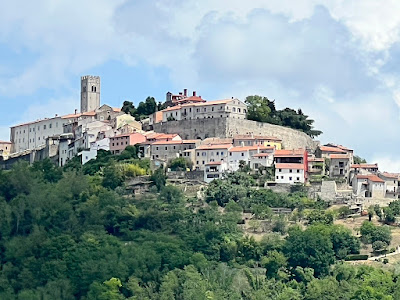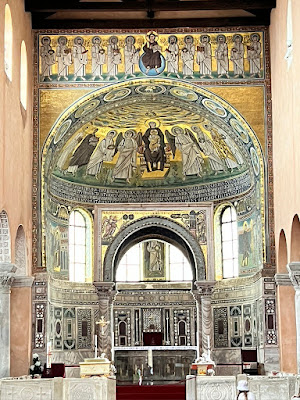--The Tuscaloosa News (AL), May 10, 1915
There is so much to say about the Croatian region of Istria, which is located in the western section of the country, borders Slovenia and is very close to Italy. Istria forms a rough triangle, or heart-shape, pointing to the south into the Adriatic Sea. Truffles and pasta, delicious seafood and Boskarin beef, vampires, giants, and faeries, ancient Roman ruins, Teran and Malvazija grapes, beautiful beaches, majestic mountains, and so much more.
During our second week touring Croatia, we spent time in Istria, visiting wineries and exploring the region, which receives few American tourists, despite offering much to see and do. For example, in 2021, about 284,000 people from the U.S. traveled to Croatia but only about 19,000 of them, less than 7%, visited the region of Istria. That needs to change as Istria is such a fascinating destination, worthy of increased tourism from the U.S.
There is so much to say about the Croatian region of Istria, which is located in the western section of the country, borders Slovenia and is very close to Italy. Istria forms a rough triangle, or heart-shape, pointing to the south into the Adriatic Sea. Truffles and pasta, delicious seafood and Boskarin beef, vampires, giants, and faeries, ancient Roman ruins, Teran and Malvazija grapes, beautiful beaches, majestic mountains, and so much more.
During our second week touring Croatia, we spent time in Istria, visiting wineries and exploring the region, which receives few American tourists, despite offering much to see and do. For example, in 2021, about 284,000 people from the U.S. traveled to Croatia but only about 19,000 of them, less than 7%, visited the region of Istria. That needs to change as Istria is such a fascinating destination, worthy of increased tourism from the U.S.
Istria, which consists of approximately 2,820 square kilometers, has a coastline that is about 537 kilometers long. There are also about 636 villages, towns and cities in the region, and the largest city is Pula, while the smallest city in Hum, which also happens to be the smallest city in the world (with a population of about 21). Traveling from the flatter lands of Slavonia, it was a big change encountering the hills, mountains and coastline of Istria. It's a verdant region, and parts of it might remind you of Italy, especially considering Italian is a second language here, where many signs are in Croatian and Italian.
Interestingly, the only dinosaur bones found on the Mediterranean coast were found in Istria. Istria derives its name from the Histri, an Illyrian tribe which originally inhabited the region, and which were said to be pirates. In 177 B.C., the ancient Romans finally conquered the Histri, and referred to the Istria region as "Terra Magica," the "land of magic." Over the coming centuries, Istria was conquered by various peoples from the Goths to the Byzantines. In the 13th century, the western and southern portion of Istria was controlled by the Republic of Venice, while the eastern portion was controlled by the Habsburgs.
Interestingly, the only dinosaur bones found on the Mediterranean coast were found in Istria. Istria derives its name from the Histri, an Illyrian tribe which originally inhabited the region, and which were said to be pirates. In 177 B.C., the ancient Romans finally conquered the Histri, and referred to the Istria region as "Terra Magica," the "land of magic." Over the coming centuries, Istria was conquered by various peoples from the Goths to the Byzantines. In the 13th century, the western and southern portion of Istria was controlled by the Republic of Venice, while the eastern portion was controlled by the Habsburgs.
Starting in 1797, and into the 19th century, the entirety of Istria was passed back and forth several times, first to the Habsburgs of Austria and then to the Kingdom of Italy. Next, it was transferred to France and later back to Austria, where it would remain until after World War I, when it was given back to Italy in 1920. However, after World War II, Istria became part of Yugoslavia, until Croatia attained its independence. Thus, families who lived in Istria may have had members who possessed citizenship from various countries.
This is quite a shocking and intriguing incident from the past, when Austria still controlled Istria. In the Mount Carmel Daly Republican (IL), November 24, 1900:, there was an article which stated: “In Austria they arrest babes for high crimes and misdemeanors. The court in Parenzo, a town in Austria’s Italian province of Istria, recently afforded the spectacle of two baby brothers, three and five years old, Pao and Leo Franco, being charged with sedition, in that they did cry ‘Viva Istria, Italiana.’ A day or two before a festival was celebrated, in the course of which this cry was raised. The two infants heard it, and the next day, while playing near the police barracks they babbled the cry. Thereupon they were arrested, imprisoned, tried formally, adjudge guilty and sentenced to be severely reprimanded."
As Terra Magica, Istria has many legends about supernatural creatures and elements. I previously wrote about the tale of the Vampire of Kringa, the first documented, historical incident concerning a European "vampire." There are also three megalithic circles in Istria, the only ones in Croatia, and it's claimed that ley lines, known as "dragon lines," pass through these circles, as well as towns including Motovun, Grožnjan, and Opatalj. Ley lines are allegedly lines of energy which connect important locations. It's claimed that three ley lines intersect beneath Motovun, which provide great positive energy for the village.
In the Mirna River Valley, near Motovun, there are legends of great giants who allegedly constructed some of the old towns of Istria, including Motovun. They also allegedly constructed the Amphitheatre in Pula. Most of the giants vanished over time, but allegedly one, Veli Jože, remained behind in Motovun, helping humans, and a fairy tale of his life was written by Vladimir Nazor in 1908, which is now a beloved children's tale. There are also tales of faeries in Istria, and there's another legend that they were the ones who constructed the Pula Amphitheatre. They supposedly built the amphitheater in one night, but didn't have enough time to construct a roof for it, leaving it to be an open-topped arena.
In the Mirna River Valley, near Motovun, there are legends of great giants who allegedly constructed some of the old towns of Istria, including Motovun. They also allegedly constructed the Amphitheatre in Pula. Most of the giants vanished over time, but allegedly one, Veli Jože, remained behind in Motovun, helping humans, and a fairy tale of his life was written by Vladimir Nazor in 1908, which is now a beloved children's tale. There are also tales of faeries in Istria, and there's another legend that they were the ones who constructed the Pula Amphitheatre. They supposedly built the amphitheater in one night, but didn't have enough time to construct a roof for it, leaving it to be an open-topped arena.
Istria is well known for its wine and gastronomy, some which has an Italian influence. Pasta, especially Fuži, and risotto dish are prominent. Black and white truffles are prevalent, especially in the area around Motovun. With a lengthy coastline, seafood is also fresh and popular. Istria is also renowned for its olive oil, which has often won worldwide awards. On my first trip to Croatia, I brought home several bottles of Istrian olive oil, which were superb. Istria is also the home to Boškarin, cattle which nearly went extinct but were brought back from the brink, and now have become a gourmet treat.
Today, there are only about 4,000 hectares of vineyards in Istria, a drastic reduction from the pre-phylloxera period, when Istria had about 44,000 hectares. Parts of the region are well known for its terra rossa, "red soil," which is an iron-rich soil. Two of the most important grape in Istria include the white Malvazija Istarska and the red Teran. The region also produces some intriguing spirits and liqueurs, including Biska, Medica, Pelinkovac Epulon and Teranino.
Famed Chef Lidia Bastianich was born in Istria, and described her childhood there in her cookbook, La Cucina Di Lidia: Recipes and Memories From Italy’s Adriatic Coast (1990). She was born in the city of Pula in 1947, when Yugoslavia controlled the region. She grew up in a small, poor village, and her husband, Felice, noted, “Whenever anyone in a village got hold of a prosciutto bone, it would be passed from one family’s pot to another’s, until there wasn’t a trace of its flavor left. Sometimes, the last ones to get it only imagined they could taste it in a soup.”
Author James Joyce lived and worked in Pula, writing much of A Portrait of the Artist as a Young Man, and there is a statue of him at a cafe in Pula.












No comments:
Post a Comment